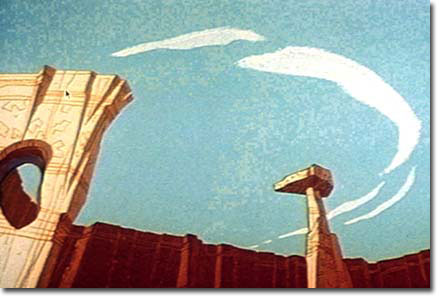Orange County Museum of Art,
Oct 12, 2004 - Jan 30, 2005
Newport Beach, Ca, USA
California Biennial, 2004
by Eve Wood
The ability to conjoin playful intelligence with a sense of hubris is what marks the work of Glenn Kaino whose sculptural work "Desktop Operation: There’s No Place Like Home (10th example of Rapid Dominance: Em City), 2003," recreates the Emerald City in the Wizard of Oz as a Zen sand garden often found on executive desktops. This piece is only represented in the catalogue, and in my opinion, should have been included in the show. Drawn in the sand around the castle is a diagram outlining a series of tactical maneuvers for attacking the famed and impenetrable city of OZ. Kaino’s work postulates the familiar premise that "absolute power corrupts absolutely," though in Kaino’s world, imagination with all the incumbent vicissitudes of power, supercedes the impulse to destroy fused into singular metaphoric units of space and time. His other work "Simple System For Dimensional Transformation," is very big and very busy, but lacks the same power and simplicity that makes his other work so compelling.
Considering today’s political climate, Karl Haendel’s drawing, "Floating Hitler Head," adorned with a flourish of the artist’s own pubic hair, Hitler’s signature mustache, clipped and coifed, shows us that the iconic image of evil can still be turned on its ear, and yet strangely, because the image is not situated in relation to its background or foreground, it appears to gather power by the very fact of its stillness. Haendel may be on to something, however, I feel somehow that I’ve seen this work a hundred times before, and the fact he hires assistants to do the work for him, points once again, in this critic’s mind at least, to the issue of ownership, and the importance of the artist’s own hand being seen and felt in the work. Shirley Shor’s piece "Landslide," is stunning in that it combines computer-generated imagery made from a unique combination of software, video projection and a sculptural element with a distinctly human sensibility. A pattern of constantly shifting "color coordinates" flash across a pile of sand in a sandbox. The simple beauty of sculpture is combined with the complexity of the video work which operates with light and shape and color, and yet this work pronounces itself subtly. At first, the patterns seem disparate, yet if the viewer really spends some time with this piece, you come to understand that these colored shapes and patterns create the shapes of countries, borders that ultimately speak to issues of dominance and power. What is most fascinating about this work is the slow overtaking of a single color as separate from the rest. One color must invariably begin to dominate all the rest, destabilizing this gorgeous democracy of color into a totalitarian nation of a single dominant hue. Somehow this sounds very familiar.
Other works in the show refer to deeper, more personal psychological trauma. Josephine Taylor’s images of strangely disassociated children are deceptively seductive. Beautifully rendered in soft pastels that seem almost to spring from the page, luminous and towering, yet as with Shor’s work, one must look more closely to see that these faces hold their grief at the surface. A lip curls downward, or a young girl’s eyes are averted in "Lay Very Still," presupposing some nameless transformation into sorrow. Two girls (the artist and her sister) lie pressed into each other, as though closeness were the only protection. Taylor’s drawings are directly related to her own past, and while these works might easily fall into the category of the falsely sentimental or maudlin, they manage to successfully resist the very trauma upon which these images are predicated on. They stand as monuments to grief, and Taylor’s hand, so present in the work, functions through its precision, to bring us closer to her experience without slamming our heads into the proverbial wall of intention.
|













